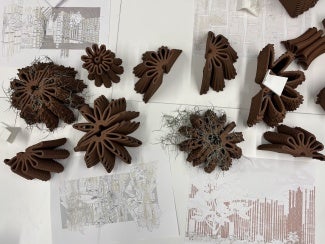Are students prepared for practice?
Firm experience and good instruction can temper the transition from classroom to professional life.
After design school, recent graduates sometimes find architectural practice daunting and disheartening. Prior firm experience can temper the transition, as can learning from instructors with a foothold in the profession.
“There is a baseline expectation that accredited schools of architecture [offer] a version of professional practice,” says Emilie Taylor Welty, AIA, who is the program director at the Tulane School of Architecture and Built Environment and principal of the New Orleans design firm Colectivo. Tulane’s professional practice training, for instance, consists of two courses, one on the business of design and another on design technology.
Still, no institution can teach the full breadth of design practice in three to five years. Architects wear many hats, and the industry is constantly evolving amid a “sea of social and technological change,” as described in the 2025 report Building Impact. RAND Education and Labor created the report, with support from AIA, the National Council of Architectural Registration Boards (NCARB), and the Association of Collegiate Schools of Architecture (ACSA).
According to the report, “Students and practicing professionals expressed a gap between what is taught in programs and what is needed in professional practice.” For example, just over half of students surveyed in RAND’s research believed their educational program adequately prepared them in building technology and technical skills and documentation. The report recommends strengthening “collaboration among universities, professional firms, and associations to bolster curriculum and advance innovation in architectural programs.” Fortunately, perhaps more than ever, dialogue and feedback loops are happening among licensure candidates, academia, and organizations.
Redefining design excellence
Every design institution shapes its curriculum differently, but ideally, they are aware of changes in the profession and in student interests. In the past two decades, Taylor Welty has seen design studios and coursework promote collaborative group work. “In many ways, that mirrors what we see in practice,” she says. “You’re never designing in isolation.”
Over the past decade, she has seen greater emphasis on research, both in studios and thesis work. And in the past five years, Tulane moved its professional practice course on design technology, such as building information modeling software, earlier in its curriculum sequence based on feedback from students and hiring alumni. As a result, Taylor Welty says, “Students going into internships while they’re in school are able to more deftly navigate their own role in a firm. It has been to the benefit of our students, but also to the firms.”
That strategic shift is likely music to the ears of Coffee Polk, AIA, a Las Vegas–based senior associate at the design firm Cuningham and an at-large director on NCARB’s board. Like many practitioners, Polk does not have the bandwidth to teach design software basics to recent hires at her firm. “Am I going to ask them to model a complex stair and railing?” she asks. “On day one, no, but we’ll get you there. I would like them to be able to put windows in a wall, draw a room, and adjust a basic room schedule.”
Job candidates should ask their interviewer which software programs their firm uses, Polk adds. “If you don’t know it, go learn it,” she recommends. “YouTube university is amazing.”
Closing the gap
Transparency about professional practice and the licensure process early in the pipeline can help students form realistic expectations, says Jared Zurn, AIA, chief programs officer at NCARB. They can then research which design schools align with their interests and different professional roles within architecture. “NCARB firmly believes in a good, broad-based education that explains to students what it means to be a practitioner,” Zurn says.
Tulane organizes career days for firms to meet and interview students for summer internships or full-time positions, per Taylor Welty. “We also have a robust programming team that sets up firm crawls and mentor dinners where local practitioners [speak about design practice].”
Based on personal experience, Zurn sees tremendous benefit in interspersing formal education with firm experience. A full-time co-op position after his third year of school exposed him to “real architecture,” he says. “I came back and was processing very differently [everything] that was being poured into my brain in those last two years of education.”
Improving the licensure process
Understanding what being an architect really entails can help students decide if licensure is on their horizon. If so, they can begin accruing and reporting experience hours as required by NCARB’s Architectural Experience Program (AXP) right after high school. As they check off prerequisites in the six practice areas defined by NCARB, they can start taking the respective divisions of the Architect Registration Examination (ARE).
Through its Pathways to Practice initiative, NCARB continually assesses the AXP and ARE for improvement opportunities. For example, a July 17 press release announced upcoming updates to the licensure process that will “reflect the capabilities necessary at the point of initial licensure as an architect, as well as address common administrative impediments faced by candidates.”
NCARB has a “robust outreach campaign” that seeks input from various parties in architecture, Zurn explains. Various committees mix state licensing board members with practitioners, academics, and licensure candidates to review potential policy, program, and exam changes. Additionally, NCARB engages with its alliance organizations, such as AIA and ACSA, and design faculty at events like its NCARB Scholars in Professional Practice program.
Following each examination attempt, NCARB surveys each candidate for feedback, Zurn adds. The organization shares detailed data and findings on its licensure process through vehicles such as its annual NCARB by the Numbers report and tables of ARE pass rates by design school.
Firm support for ARE
Approximately one-third of practitioners surveyed in the RAND study “wished their firms provided more support for growth and success” in building technical systems and performance models, professional practice and ethics, and sustainability. Polk says firms can cultivate early career designers by providing diverse experiences. “It’s a no-brainer for the future of both the profession and your firm,” she says. “You want your new designers to become licensed professionals because they’re your pipeline.”
Cuningham shuffles licensure candidates to different project teams to ensure they meet their AXP requirements. The firm may even temporarily relocate candidates if they, for example, need more site experience but their home office is light on projects in construction. Cuningham subsidizes 24 hours of continuing education each year per designer, holds licenses for ARE preparation software, and subsidizes employee ARE fees for all six divisions—plus “one oopsie,” or failed attempt, Polk adds. Designers interested in attending industry events or taking paid courses can apply for reimbursement by demonstrating that the experience will be valuable.
Continuous improvement
Many design institutions and organizations monitor, measure, and tweak their programs and operations to ensure future architects thrive. NCARB regularly checks in with state licensing boards to see if the quality of work by recently licensed architects is causing issues, Zurn says. “That would be a signal to us that something’s not working in the licensure process,” which, he notes, hasn’t been the case.
Every semester, Tulane faculty review their curriculum in a two-day meeting, Taylor Welty says. “It’s our chance to go through class by class to understand how classes connect to each other, whether we’re achieving our learning objectives, and to talk about shifts we want to make.”
Polk believes design schools are generally successful at teaching students “the flexibility of thought that’s necessary for architects to respond to and create new things that work well with change.” Daring to ask questions, invite feedback, and adapt appropriately are critical for success in a profession as dynamic as architecture.
Wanda Lau is a freelance writer covering architecture and design and a former editor of ARCHITECT magazine. She lives outside Chicago.






